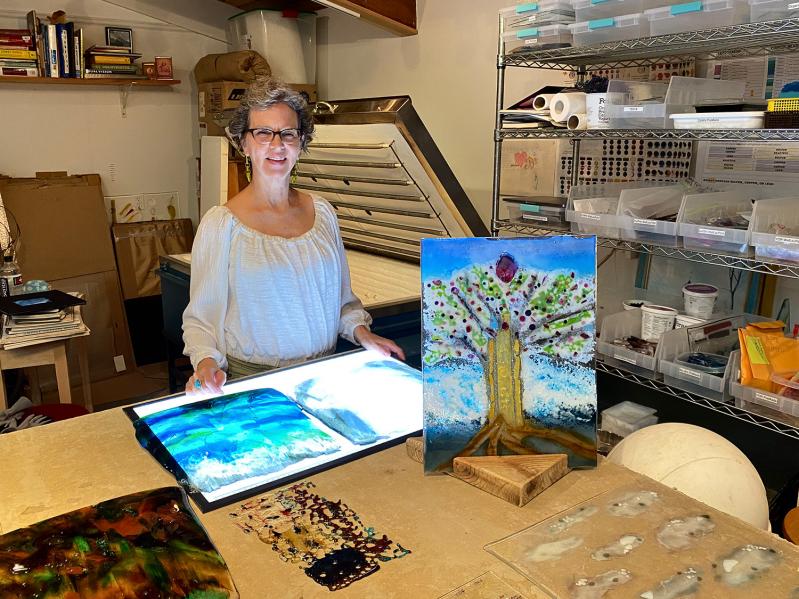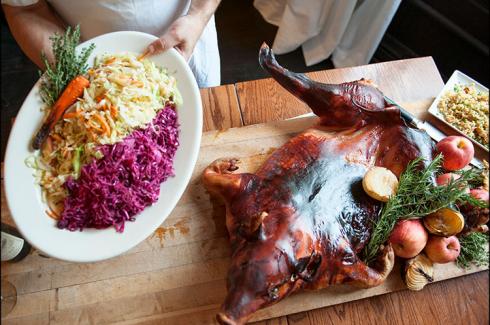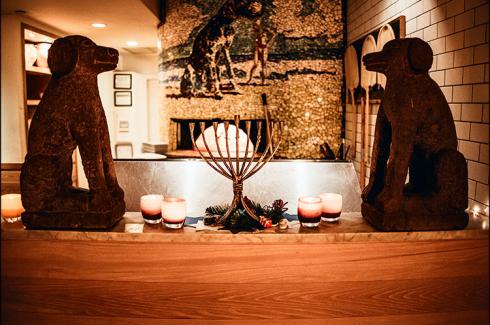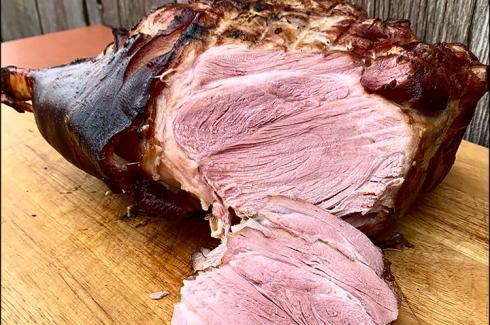Twenty-three years ago, Isabella Rupp decided to take one year to do everything she was afraid of. First on her list was art. Not just any kind of art, but glass art.
She had never taken a studio art class. With no idea what she would do as a career, she majored in economics at Fairfield University in Connecticut "because it was a liberal arts major and it allowed me to take the things I really wanted to take, which were philosophy, writing, and art history," she said during a conversation at her studio in Noyac.
In fact, college launched her in a very different direction from glass art. During her senior year she interned at CPTV, a public television station on the Fairfield campus. After graduation in the early '80s, she landed a job at MTV, where she was trained by the chief engineer and hired to a technical position.
Several decades of work in television followed. "For a number of years I was a technical director, and for a number of years I was writing and producing," eventually working at CNBC.
And she was still at it in 2000, when she decided to take that leap into the world of glass. She took a workshop with Valerie Carmet, an artist living in TriBeCa who began her career as a mosaicist. That was where Ms. Rupp made her first mosaic, which she later named "Becoming Isabella."
In August of that year she worked with Virginia Gabaldo, a mixed-media artist, for a week-long intensive in Taos, N.M. That summer Ms. Gabaldo focused on fused sculptural glass and introduced Ms. Rupp to melting glass into new forms through the use of kilns.
During a December 2000 blizzard, a friend suggested Ms. Rupp take her work to H2K, a gallery in Chelsea, her neighborhood at the time. When she brought "Becoming Isabella" to the gallery, she told the gallerist, " 'Here's one of mine,' as if I had more than one." She was told she could have a show in April, which gave her 90 days to create enough work.
Almost immediately thereafter, while on vacation, she was reading a book by an Italian writer named Francesca. Because she had been named Nancy by her parents, Isabella was not yet Isabella. With an art show coming up, she decided she needed a more interesting name to sign her work. So becoming Isabella coincided with "Becoming Isabella."
Titled "Luminous," the show opened in April 2001. Most of the work sold, and commissions and other shows followed, including one at the Siena Spirituality Center in Water Mill, where the dealer Sara Nightingale awarded Ms. Rupp the Fra Angelico award for her mosaic "Isabella 2."
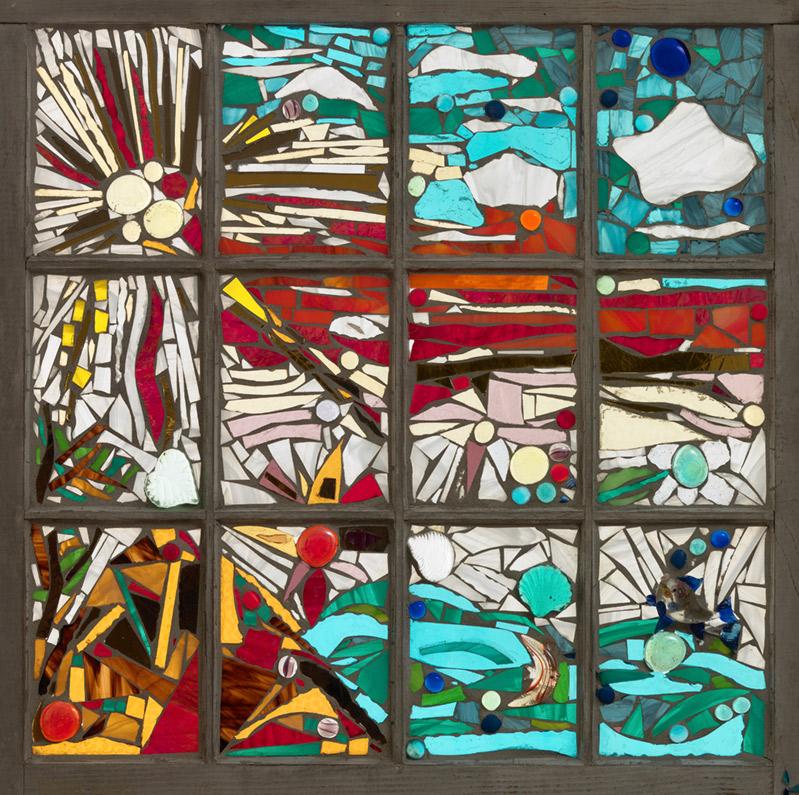
Helen Harrison, in a New York Times review, wrote of the piece, "A clever amalgam of flat and modeled glass enlivens the imagery, in which earth, air, fire (the sun), and water interact with and complement each other."
Mosaics were her introduction to glass art. While mosaics are usually made before being framed, Ms. Rupp, who liked windows so much she had one hanging in her apartment, began salvaging windows in the city, especially older ones with wavy glass.
The original window glass remains in the frame, as sort of a canvas on which pieces of glass of varying colors and shapes are glued. No heat is involved in the mosaic process. She had to do a lot of experimenting with glue, because the first one she used could be removed with Windex. She sometimes incorporated sheer fabric on the back of the windows for sky, other times paint for beach sand and ocean.
At the time of that first exhibition in New York, Ms. Rupp was living in a 500-square-foot apartment on West 23 Street, where she set up a studio under her loft bed. Before long she realized that was not working. After looking at studios in Queens and Brooklyn, she realized she wanted to be in nature and she wanted to expand, "because that's when I was starting to imagine making my own components with a torch, which is a bit complicated in Brooklyn."
Having grown up in Northport, she was familiar with the East End, where she had waitressed during college summers at a restaurant on the Shinnecock Canal. She bought her house in Noyac and moved there in 2002. "The area hadn't been fully discovered, and the house needed a lot of work, so I could manage it." And it had a two-car garage, which she immediately envisioned as a studio.
It took years, but the studio is now fully equipped with two kilns, one 30 by 60 inches that was custom-made for her, a smaller kiln, a torch, and racks and racks of jars containing frit, or crushed glass, from which she makes her glass components.
Her process involves mixing multiple types of factory glass using heat, gravity, and time. The individual components are transformed into unique sheets of glass with patterns of intermixing colors. She then cuts the handmade sheets and creates a composition, which then goes back into the kiln where it is fused together into a new whole. Each composition might undergo several firings to add texture, depth, and luminosity.
Ms. Rupp has also made installations both at her home and at Hamptons Float, a spa in Water Mill that offers flotation therapy. The Water Mill installation, in the venue's waiting room, consists of two large windows, each 48 by 72 inches, consisting of fused glass powder, frit, pigment, and LED lighting installed in the window frames.
The venue wanted privacy for its clients after they floated, but it didn't want to block the outside with curtains or shades. The glass is densely bubbled, which creates a feeling of being underwater, blurring the outside while letting light in. The windows are also decorated with glass clouds and other colorful elements, all made from powders and frits.
Over the years, Ms. Rupp studied at Bullseye Glass in Mamaroneck, N.Y.; Urban Glass in Brooklyn, where she won three scholarships; twice at the Pitchuck Glass School in Seattle, co-founded by Dale Chihuly, and at the Studio at the Corning Museum of Glass in Corning, N.Y.
"I've taken a lot of classes to really learn how to use these tools," she said. "I wanted to learn technically how other glass artists work, but I don't want to make work that is like theirs.
She continued to work in television after leaving New York, and with summers off from that job and a schedule that allowed her to work three long days each week and then return to her studio, she managed to keep both balls in the air.
Then she had an opportunity to study with Narcissus Quagliata, who, she said, "is to glass art like what Beethoven is to classical music. He invited nine of us to work with him for about a year and a half. It was intensive critique." While she had shown work, sold work, and won prizes, "I felt I had all these puzzle pieces, but I needed consistent time. I'd been doing glass for 23 years, it was time to take a leap of faith and do it full time."
She has recently created layered works, in which several pieces of glass are placed vertically and parallel to each other within wooden supports. Those works use a variety of techniques and temperatures to transform sheet glass, powder, frit, stringers (spaghetti-like strands of glass), glass rods, enamel, and pigment.
She and her husband, Steve Rosborough, an artist from Canada, were married eight years ago. He makes the frames for her layered pieces, and built the window frames for the Hamptons Float installation. He also constructed a treehouse on their property that they designed together.
Its mosaic windows include one of a green Tara, a Buddha, and one of Vajrayogini, the female embodiment of the cognitive function leading to Buddhahood. The couple uses it as a meditation space. "My Buddhist practice inspires my glass practice, as I attempt to make the invisible visible," she said.

